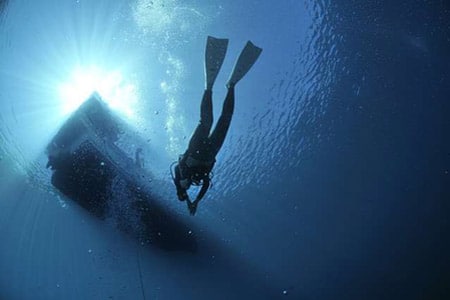This month, Camping Lou P’tit Poun invites you to discover the Gouf de Capbreton, a spectacular underwater canyon that plunges to a depth of 4,000 m. Let’s take a trip to 20,000 leagues under the sea, where we reveal some of the mysteries of the Capbreton gulf!

Where is the Capbreton gulf?
Located in the Bay of Biscay, off the coast of Capbreton and Hossegor, the Capbreton gulf (which means “chasm” in Gascon) begins just a few hundred metres from the Landes coast. It stretches some 300 km across the abyssal plain of the Bay of Biscay to Santander in Spain, between the Aquitaine Plate to the north and the Cantabrian Plate to the south.
How deep is the Capbreton gulf?
It’s one of the world’s deepest underwater canyons, with a morphology reminiscent of the Grand Canyon in Colorado, USA. This immense underwater valley plunges to a depth of 4,500 metres, with winding slopes, meanders, plateaus and abyssal precipices.
How was the Capbreton gulf formed?
The Capbreton gulf is a unique underwater canyon formed by the spreading of two tectonic plates 20 million years ago, during the Cretaceous period, in the extension of the ancient bed of the Adour, which once flowed into Capbreton, before the river was diverted to Bayonne in 1578 by the engineer Louis de Foix.
The origin of Hossegor’s finest wave
The Capbreton gulf plays a role in the formation of the most beautiful wave on the Landes coast: “La Nord”, facing the central beach of Hossegor. World-renowned by professional surfers, this mythical and monstrous wave is surfed by many professionals during the ASP World Tour Surfing Championships.
An extraordinary fish tank for anglers
For the fishermen of the Landes region, the depths of the Capbreton gulf are a dream come true. The upwelling of cold water into warm waters favors plankton, on which a rich diversity of marine species feeds, and thus encourages sea fishing. The Capbreton gulf is a veritable larder for rock and deep-sea fish, as well as numerous crustaceans and cephalopods (squid, octopus…). A godsend for Capbreton ‘s fishermen, who catch a wide variety of fish, large and small, including bluefin tuna and anchovy.
Mysterious and fantastic underwater fauna
Due to its size, geology and geographical location, the Capbreton marine trench is home to exceptional marine biodiversity. This ever-changing ecosystem is home to numerous sedentary and migratory fish, some of them native to warm seas, and several marine mammals that are rather rare on our coasts. These specimens include the bottlenose dolphin, orcas, sperm whales, whales, Minke whales, giant jellyfish… At the end of the summer, we encounter subtropical species that are extremely rare on our coasts, such as the sunfish, and even penguins during the winter! As for the legendary giant squid, it reigns in the abysses of the gulf…
Visit the Capbreton gulf
Unless you’re an extreme diver, it’s difficult, if not impossible, for the average person to explore the depths of the Landes chasm. Nevertheless, the Cité de l’Océan in Biarritz offers an innovative device that takes you on a virtual stroll inside the famous fault, modeled in 3 dimensions. Fly over the underwater canyon, following the route on a 2D map and the evolution of depths on a dashboard.
Since 2015, the town of Capbreton has organized a Gouf Day every other September, celebrating this extraordinary underwater canyon in all its forms, as seen by scientists, historians, fishermen divers, surfers and artists.
photo@Masako Uchida, pixabay
